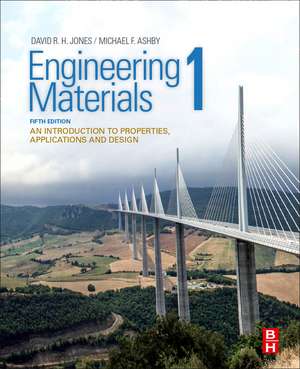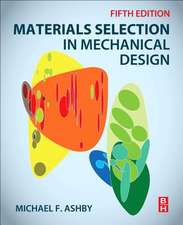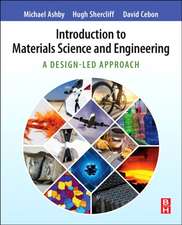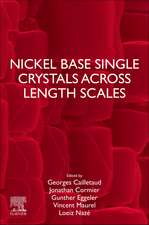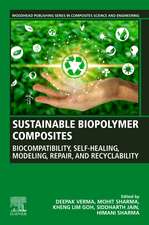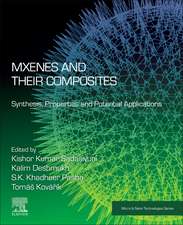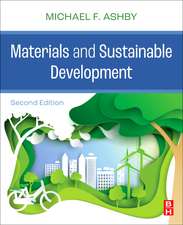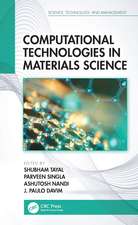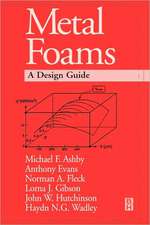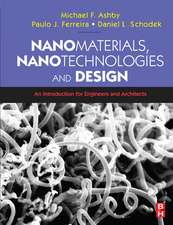Engineering Materials 1: An Introduction to Properties, Applications and Design
Autor David R. H. Jones, Michael F. Ashbyen Limba Engleză Paperback – 15 dec 2018
This fifth edition boasts expanded properties coverage, new case studies, more exercises and examples, and an improved pedagogy. It is perfect as a standalone text for a one-semester course in engineering materials, or as a first text with its companionEngineering Materials 2: An Introduction to Microstructures and Processing,in a two-semester course or sequence.
- Covers new chapters on magnetic, optical, thermal and electrical properties, with appropriate case studies on their applications
- Presents an improved pedagogy, featuring more relevant photographs, a new glossary of terms, additional worked examples, and 50% more exercises than in the previous edition
- Provides additional discussions on supply and demand
- Includes new case studies on medical materials/biomaterials
Preț: 332.06 lei
Preț vechi: 397.27 lei
-16% Nou
63.54€ • 66.52$ • 52.57£
Carte disponibilă
Livrare economică 10-24 martie
Livrare express 01-07 martie pentru 134.47 lei
Specificații
ISBN-10: 0081020511
Pagini: 586
Dimensiuni: 191 x 235 x 28 mm
Greutate: 1.23 kg
Ediția:5
Editura: ELSEVIER SCIENCE
Public țintă
Mid and senior undergraduate level courses in departments of mechanical engineering; materials sciences; manufacturing; engineering design; materials design; product design; aeronautical engineering; engineering sciences. Particularly suitable as a one-semester course text.Cuprins
1. Engineering Materials and Their Properties Part A: Price and Availability 2. The Price and Availability of Materials
Part B: The Elastic Moduli 3. The Elastic Moduli 4. Bonding between Atoms 5. Packing of Atoms in Solids 6. The Physical Basis of Young's Modulus 7. Case Studies in Modulus-Limited Design
Part C: Yield Strength, Tensile Strength, and Ductility 8. Yield Strength, Tensile Strength, and Ductility 9. Dislocations and Yielding in Crystals 10. Strengthening Methods and Plasticity of Polycrystals 11. Continuum Aspects of Plastic Flow 12. Case Studies in Yield-Limited Design
Part D: Fast Fracture, Brittle Facture, and Toughness 13. Fast Fracture and Toughness 14. Micromechanisms of Fast Fracture 15. Probabilistic Fracture of Brittle Materials 16. Case Studies in Fracture
Part E: Fatigue Failure 17 - Fatigue Failure 18 - Fatigue Design 19 - Case Studies in Fatigue Failure
Part F: Creep Deformation and Fracture 20. Creep and Creep Fracture 21. Kinetic Theory of Diffusion 22. Mechanisms of Creep, and Creep-Resistant Materials 23. The Turbine Blade--A Case Study in Creep-Limited Design
Part G: Physical Properties 24. Thermal Properties 25. Electrical Properties 26. Magnetic Properties 27. Optical Properties
Part G: Oxidation and Corrosion 28. Oxidation of Materials 29. Case Studies in Dry Oxidation 30. Wet Corrosion of Materials 31. Case Studies in Wet Corrosion
Part H: Friction, Abrasion, and Wear 32. Friction and Wear 33. Case Studies in Friction and Wear 34. Final Case Study: Materials and Energy in Car Design
Descriere
Engineering Materials 1, Fifth Edition: An Introduction to Properties, Applications and Design provides a broad introduction to the mechanical and environmental properties of materials used in a wide range of engineering applications. The text is deliberately concise, with each chapter designed to cover the content of one lecture. As in previous editions, chapters are arranged in groups dealing with particular classes of properties, with each group covering property definitions, measurement, underlying principles, and materials selection techniques. Each group concludes with case studies that demonstrate practical engineering problems involving covered materials.
This fifth edition boasts expanded properties coverage, new case studies, more exercises and examples, and an improved pedagogy. It is perfect as a standalone text for a one-semester course in engineering materials, or as a first text with its companion Engineering Materials 2: An Introduction to Microstructures and Processing, in a two-semester course or sequence.
- Covers new chapters on magnetic, optical, thermal and electrical properties, with appropriate case studies on their applications
- Presents an improved pedagogy, featuring more relevant photographs, a new glossary of terms, additional worked examples, and 50% more exercises than in the previous edition
- Provides additional discussions on supply and demand
- Includes new case studies on medical materials/biomaterials
